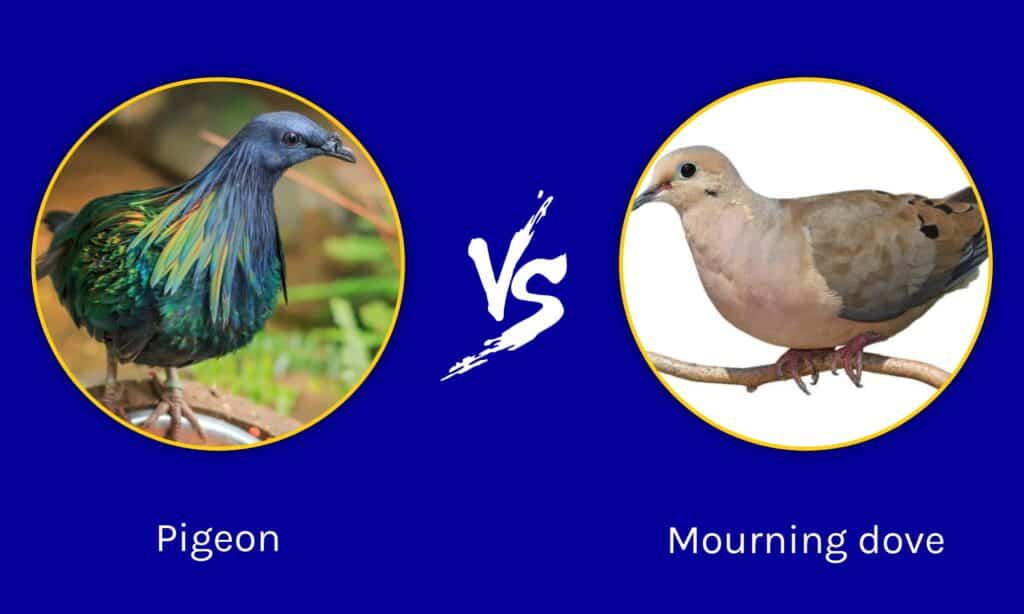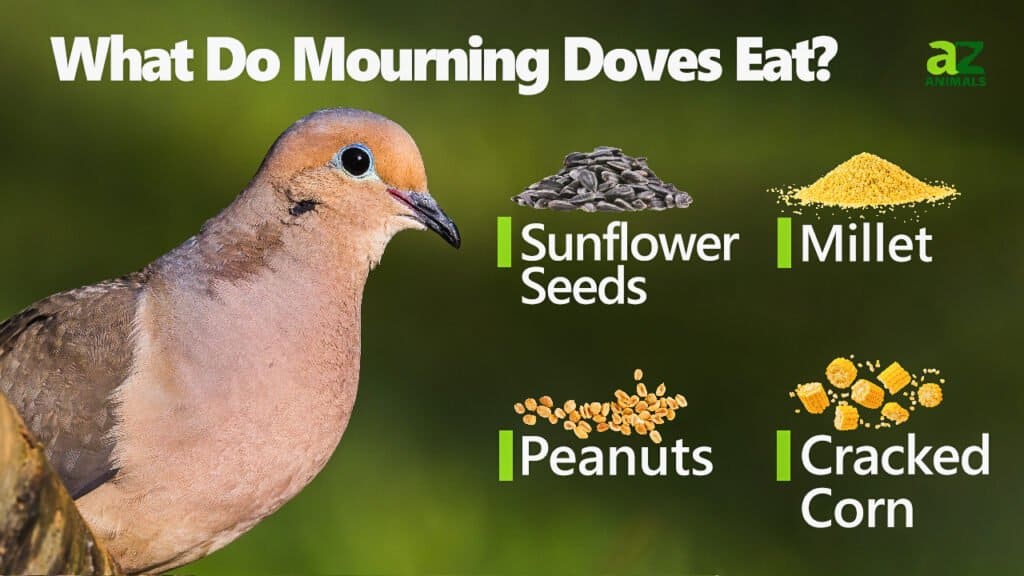Courtesy of the way doves and pigeons have been used interchangeably in this present time, many people would assume that there is one description for the two birds. Interestingly, pigeons are not doves, and doves are not pigeons. This article will examine this small, plump, small-billed bird (pigeon) and the legendary mourning dove to point out the differences.
Comparing a Pigeon and a Mourning Dove

| Pigeon | Mourning Dove | |
|---|---|---|
| Family | Columbidae | Columbidae |
| Size | Length: 6-24 inches Weight: 0.58125 -0.8375 lbs Wingspan: 19.7-26.4 inches | Length: 8.9 -14.2 inches Weight: 0.28125 – 0.375 lbs Wingspan: 14.6 – 17.7 inches |
| Morphology | Small heads, short necks, stout bodies, and short legs | Roundhead with tan coloration. |
| Habitat | Often found in towns and cities, as well as farmlands, fields, and rocky cliffs worldwide. | Mostly found in any open or semi-open habitat in temperate parts of North America, including forest clearings, farmland, suburbs, prairies, and deserts. |
| Social Behavior | Can live in isolation or in groups. Pigeons are monogamous and, by default, have a mate throughout their lifetime. | Can also live in isolation and in groups. Mourning doves are also monogamous. |
| Diet | Omnivore | Granivore |
| Predators | Opossums, raccoons, red-tailed hawks, great horned owls, eastern screech owls, accipiters, American kestrel, golden eagles, and may even include gulls, crows, and ravens. | Raccoons, hawks, owls, squirrels, snakes, cats, and dogs |
| Top speed | 95mph | 55 mph |
The Key Differences Between a Pigeon vs Mourning Dove
The differences between a pigeon and a mourning dove lie in their size, speed, appearance, predators, and diet. Let’s explore them one by one.
Pigeon vs. Mourning Dove: Size

The bigger members of the Columbidae family are called pigeons, while the smaller ones are called doves.
©Akarat Duangkhong/Shutterstock.com
Pigeons are larger than doves in a significant manner. The bigger members of the Columbidae family are called pigeons, while the smaller ones are called doves. A pigeon can be between 6 to 24 inches in length, 0.58125 -0.8375 lbs in weight, and have a wingspan between 19.7 and 26.4 inches. On the other hand, the mourning dove is smaller, having a length of 8.9 -14.2 inches, a weight of 0.28125 – 0.375 lbs, and a wingspan of 14.6 – 17.7 inches.
Pigeon vs. Mourning Dove: Morphology

Mourning doves and pigeons are from the same Columbidae family.
©dontcry/Shutterstock.com
The morphology of the pigeon and the mourning dove are similar as they are from the same Columbidae family. These large Columbidaens (pigeons) have a variety of colorations that might almost be difficult to keep up with. On the other hand, the mourning dove’s coloration is always between tan and brown, its wings are blue-gray, and its tail is pointed.
Pigeon vs. Mourning Dove: Habitat
Pigeons are often found in towns, cities and farmlands, fields, and rocky cliffs worldwide, excluding the Arctic, Antarctica, and the driest parts of the Sahara desert. On the other hand, the mourning dove is native to open or semi-open habitats in temperate parts of North America, including forest clearings, farmland, suburbs, prairies, and deserts.
Pigeon vs. Mourning Dove: Social behavior
The social behavior of these two flying creatures is almost similar. Pigeons are mostly found in groups as they are safer and more effective together against predators. However, some prefer solitary living and roost on trees. Interestingly, pigeons are territorial and protect their space, particularly during the mating season. During the mating season, many male pigeons perform elaborate theatrics to attract females; these displays include exaggerated movements, slow wing beating, and, in some cases, loud clap noises produced via the wings.
On the other hand, mourning doves exhibit these similar social and behavioral traits with slight differences. They are not as territorial as pigeons who always fight to assert dominance over other birds, protect their babies, claim their mate, mark their territory, and to get their food, water or other preferred things.
Pigeon vs. Mourning Dove: Nest Building
Nest building is an interesting phase for pigeons and mourning doves as each gender takes part in constructing or looking for building materials. It is primarily the job of the males of both bird species to provide the sticks, twigs, and grasses. Among the pigeons, the male chooses a site and brings materials to the nest site one piece at a time, while the female arranges each piece to her liking. However, in the case of the mourning doves, the male takes his female counterpart to prospective sites where she makes her choice and helps out in the construction.
Pigeon vs. Mourning Dove: Diet

The diet of the pigeon and the mourning dove differ from each other. Pigeons are omnivorous in nature and consume grains, seeds, fruits, vegetables, insects, bugs, snails, and worms. On the other hand, the mourning dove is a pure herbivore that loves cultivated grains, peanuts, wild grasses, weeds, herbs, and berries.
Pigeon vs. Mourning Dove: Predators
Like most birds in their family, pigeons and mourning doves, unfortunately, find themselves in the lower chamber of the food chain. The pigeon is prey to various animals, including opossums, raccoons, red-tailed hawks, great horned owls, eastern screech owls, accipiter, American kestrel, golden eagles, gulls, crows, and ravens. However, the mourning dove is in high demand by predators like raccoons, hawks, owls, squirrels, snakes, cats, and dogs.
The photo featured at the top of this post is © iStock.com/ewastudio
Thank you for reading! Have some feedback for us? Contact the AZ Animals editorial team.






